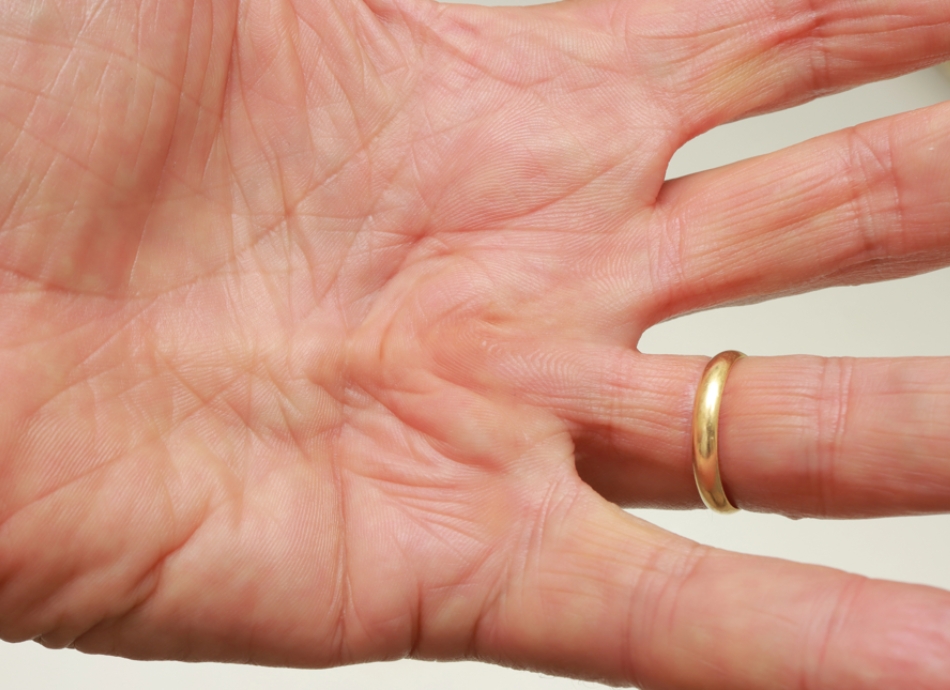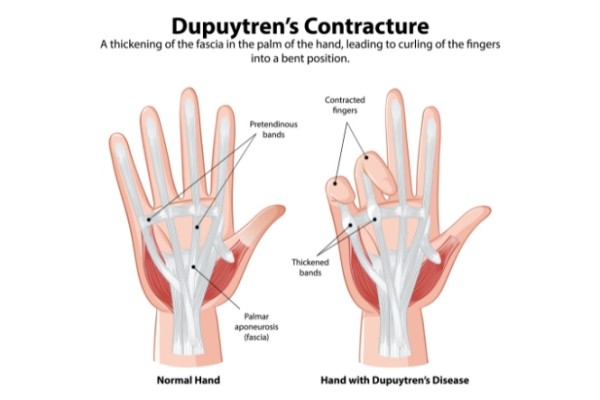Wishing everyone a safe and happy Christmas and New Year – Meri Kirihimete from the Healthify team.
Dupuytren's contracture | te whakarauora I te kukutitanga ā-matimati
Also known as Dupuytren's disease or Dupuytren's
Key points about Dupuytren's contracture
- Dupuytren's contracture is a hand condition where there's thickening of tissue in the palm of your hand.
- If this progresses, it causes 1 or more of your fingers to bend towards your palm and you can’t straighten these fingers.
- It often affects both hands and most commonly affects your little and ring fingers.
- It’s not usually painful and treatment is only needed if it progresses enough to stop you doing everyday tasks.

Dupuytren’s contracture is a condition that affects your hands and fingers.
The tissue under the skin covering the tendons in your palm becomes thickened and scarred. If this progresses, the tissue contracts (tightens and shortens) causing 1 or more of your fingers to bend into your palm. You can’t straighten these fingers.
Dupuytren’s contracture often affects both hands and most commonly affects your little and ring fingers. It mostly happens in middle-aged or older people. It’s not usually painful but it can make it tricky to do things with your hand.

Image credit: Mikk Tooming via Wikimedia Commons(external link)
Dupuytren's contracture is caused by thickening and scarring of connective tissue under the skin that covers the tendons in your palm. This tissue is called fascia.
It's not known why this happens, but you're more likely to get Dupuytren's contracture if:
Symptoms of Dupuytren's contracture are different at different stages of the condition.
- In the early stages, you may find small hard nodules or lumps in your palm. These are often painless.
- You may feel some tightness and tenderness in your palm and fingers.
- If the nodules or lumps are painful, the pain often goes away over time.
- As the condition progresses, the small nodules or lumps can become a cord of tissue.
- The cord of tissue then starts to contract causing the bending of your fingers towards your palm.
- You may feel it's difficult to straighten your fingers.
- You may also notice some skin changes around the affected area, such as dimpling and wrinkling.
- If your fingers become bent, it can make it hard to do everyday tasks and activities. It can also reduce your strength when you grip objects.
- It may affect your ring finger first and later your pinky (little finger). The index and long finger may be affected next.

Image credit: Depositphotos
You may also have thickened tissue under the skin in other parts of your body, such as thickening on your knuckles, on the soles of your feet, or on your penis.
Your healthcare provider will diagnose Dupuytren’s contracture by taking a history and examining your hand. Tests such as blood tests, X-rays or scans aren’t usually needed, unless your healthcare provider thinks your symptoms are due to other causes.
You may not need any treatment if the condition is mild and not causing problems. You may find the condition doesn’t progress beyond having lumps in your palm. If this is the case, it’s safe to wait and see if it changes over time.
If the contracture is getting worse, or interfering with hand function, your healthcare provider may refer you to a specialist. For example, you may find you can’t lie your hand flat on a table, or your finger gets in the way of daily tasks.
Treatment options
Surgery is the most common treatment when the condition has progressed. It can help to straighten your finger and improve movement and function of your hand, but it can’t cure the condition completely. If treatment is recommended, it’s best done sooner rather than later.
There are 2 main types of surgery done in Aotearoa New Zealand:
- Needle fasciotomy: A needle is used to cut the tight tissue under your skin. It’s done under local anaesthetic, which numbs the hand. This option has a quicker recovery time, but the contracture may come back sooner and is not suitable for everyone.
- Fasciectomy: This is a more involved surgery where the thickened tissue is removed through a cut in your skin. It can be done under a general or local anaesthetic. It takes longer to recover there's a lower chance of the problem returning.
If your contracture is advanced, a dermofasciectomy may be recommended. This involves removing the affected tissue and some skin, then covering the area with a skin graft.
After surgery your recovery time may be around 8 weeks depending on your surgery. You may be off work for 2 to 4 weeks, but this depends on the type of surgery and your job. Pain may limit your activities for about 6 weeks.
After surgery you will need hand therapy. This may consist of stretches, exercises or splinting.
There’s no treatment that can cure Dupuytren contracture completely. With surgery and hand therapy, hand function improves for most people, but there’s a risk that the condition will return at a later time.
Without treatment, Dupuytren’s contracture usually progresses slowly over months to years. As it progresses, it gets harder to treat so you should see your healthcare provider sooner rather than later if your condition is getting worse.
The following links provide further information about Dupuytren's contracture. Be aware that websites from other countries may have information that differs from New Zealand recommendations.
Brochures
Dupuytren's surgery patient information(external link) Southern DHB, NZ, 2016
Making a decision about Dupuytren’s contracture(external link) NHS, UK, 2022
Dupuytren’s contracture release(external link) NHS, UK, 2024
References
- Dupuytren disease(external link) Auckland HealthPathways, NZ, 2019
- Dupuytren’s contracture(external link) Patient Info, UK, 2024
- Dupuytren contracture(external link) DermNet, NZ, 2019
- Dupuytren's contracture(external link) NHS, UK, 2024
- Dupuytren’s contracture release(external link) NHS, UK, 2024
Dupuytren's contracture(external link) Patient Info Professional, UK, 2025
Moscovici M, Pace V, Marzano F, et al. Management of Dupuytren disease of the little finger(external link) J Orthop Surg Res. 2025;20:789
Credits: Healthify editorial team. Healthify is brought to you by Health Navigator Charitable Trust.
Reviewed by: Lizzy Guest, Senior Academic Staff member in Health, Toi Ohomai | Te Pukenga
Last reviewed:





